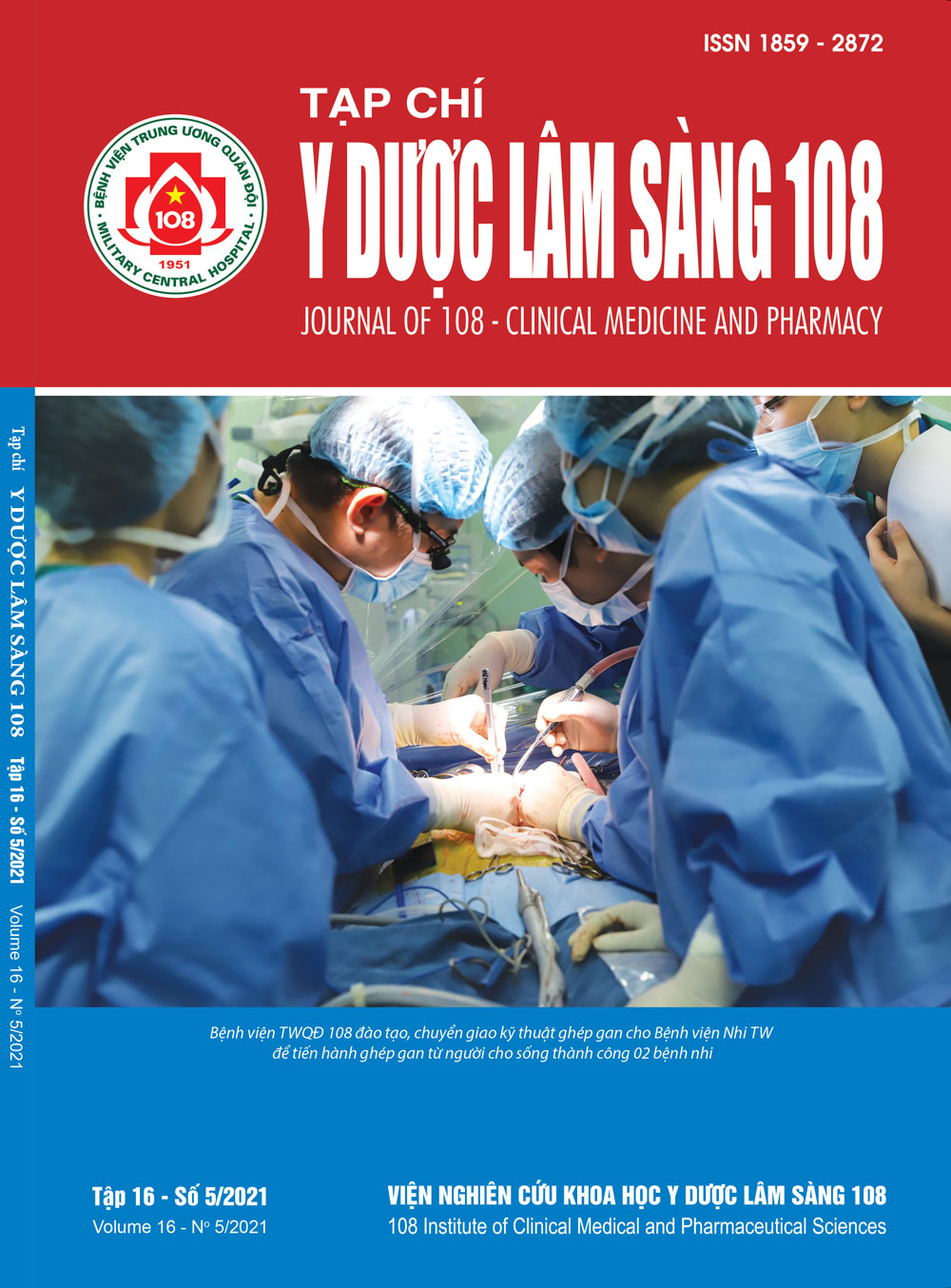Clinical outcomes of endovascular treatment for acute ischemic stroke due to large vessel occlusion in extracranial internal carotid arterial disease
Main Article Content
Keywords
Abstract
Objective: To evaluate the lesion characteristics of large vessel occlusion in extracranial internal carotid arterial disease. We also illustrate the effectiveness, safety, and clinical recovery of patients after intervention. Subject and method: 46 consecutive patients with acute ischemic stroke who underwent endovascular treatment for large vessel occlusion from January 2018 to December 2020. The method is retrospective, descriptive, longitudinal follow-up study. Result: Among 46 patients enrolled in the registry, male accounted for 87% patients, the mean age was 62.83 ± 13.03 years. The mean Glasgow at presentation was 12.65 ± 2.3, the mean NIHSS score was 15.02 ± 5.58, and the mean ASPECT score was 8.45 ± 1.33. The mean time from admission to artery groin puncture was 65.87 ± 14.43 minutes. The mean time from artery puncture to TICI 2b/3 revascularization was 41.52 ± 32.95 min. The tandem lesions accounted for 58.7%, the completely occlusion was 67.4%. 43/44 patients (97.8%) were successfully treated by stent placement, 1 patients was treated by balloon angioplasty, 01 case with hybrid treament. The revascularization rate (TICI 2b/3) was achieved in all of cases (100%). About the complications, subarachnoid bleeding due to technical accident appeared in 1 case, the cases of symptomatic intracranial hemorrhage were 3. All-cause mortality was 13.5%. Neurological recovery at the postprocedural assessed through the improvement of the NIHSS score was 86.5%. A modified Rankin Scale (mRS) score of 0 - 2 at the 3-month follow-up reached to 70%. Conclusion: Extracranial internal carotid artery disease is mainly caused by atherosclerosis. Acute endovascular mechanical thrombectomy in patients presenting with large vessel occlusion appears to be favorable and safe and carries a high chance of successful recanalization with good clinical outcomes, and the complications and mortality in a low rate.
Article Details
References
2. Petr Widimsky BK, Mark Abelson, Peter Blaškog, Peter Lanzer, MikaelMazighi, Martijn Meuwissen, Václav Procházkae, Horst Sievert, Joostde Vriesj, NelsonHopkins L (2016) Stent or balloon: How to treat proximal internal carotid artery occlusion in the acute phase of ischemic stroke? Results of a short survey. Cor et Vasa 58(2): 204-206.
3. Saqqur M et al (2007) Site of arterial occlusion identified by transcranial Doppler predicts the response to intravenous thrombolysis for stroke. Stroke 38(3): 948-954.
4. Goldstein LB, Bertels C, and Davis JN (1989) Interrater reliability of the NIH stroke scale. Arch Neurol 46(6): 660-662.
5. Pexman JH, Barber PA, Hill MD, Sevick RJ, Demchuk AM, Hudon ME, Hu WY, Buchan AM (2001) Use of the Alberta Stroke Program Early CT Score (ASPECTS) for assessing CT scans in patients with acute stroke. AJNR Am J Neuroradiol 22(8): 1534-1542.
6. Barnett HJ et al (1998) Benefit of carotid endarterectomy in patients with symptomatic moderate or severe stenosis. North American symptomatic carotid endarterectomy trial collaborators. N Engl J Med 339(20): 1415-1425.
7. Zaidat OO et al (2013) Recommendations on angiographic revascularization grading standards for acute ischemic stroke: A consensus statement. Stroke 44(9): 2650-2663.
8. Choi JY et al (2014) Emergent recanalization with stenting for acute stroke due to athero-thrombotic occlusion of the cervical internal carotid artery: A single center experience. J Korean Neurosurg Soc 55(6): 313-320.
9. Brott TG et al (2010) Stenting versus endarterectomy for treatment of carotid-artery stenosis. N Engl J Med 363(1): 11-23.
10. Kan P et al (2012) Cervical carotid artery stenosis: Latest update on diagnosis and management. Curr Probl Cardiol 37(4): 127-169.
11. Inzitari D et al (2000) The causes and risk of stroke in patients with asymptomatic internal-carotid-artery stenosis. North American Symptomatic Carotid Endarterectomy Trial Collaborators. N Engl J Med 342(23): 1693-700.
12. Rothwell PM and Warlow CP (2000) Low risk of ischemic stroke in patients with reduced internal carotid artery lumen diameter distal to severe symptomatic carotid stenosis: Cerebral protection due to low poststenotic flow? On behalf of the European Carotid Surgery Trialists' Collaborative Group. Stroke 31(3): 622-630.
13. Goodfriend SD, Tadi P, and Koury R (2021) Carotid artery dissection, in StatPearls. Treasure Island (FL).
14. Park SE et al (2018) Endovascular therapy of acute ischemic stroke related to tandem occlusion: Comparison of occlusion and severe stenosis of the proximal cervical internal carotid artery. Br J Radiol: 20180051.
15. Lockau H et al (2015) Mechanical thrombectomy in tandem occlusion: Procedural considerations and clinical results. Neuroradiology 57(6): 589-598.
16. Zoppo GJ et al (1992) Recombinant tissue plasminogen activator in acute thrombotic and embolic stroke. Ann Neurol 32(1): 78-86.
17. Nguyễn Quang Anh, Vũ Đăng Lưu, Trần Anh Tuấn và cộng sự (2013) Đánh giá hiệu quả bước đầu phương pháp lấy huyết khối bằng stent solitaire ở bệnh nhân nhồi máu não tối cấp. Tạp chí Điện quang số 14, tr. 226-232.
18. Wilson MP et al (2018) Management of tandem occlusions in acute ischemic stroke - intracranial versus extracranial first and extracranial stenting versus angioplasty alone: A systematic review and meta-analysis. J Neurointerv Surg 10(8): 721-728.
19. Vu-Dang L et al (2020) Endovascular treatment for acute tandem occlusion stroke: results from case series of 17 patients. Ann Indian Acad Neurol 23(1): 78-83.
 ISSN: 1859 - 2872
ISSN: 1859 - 2872
